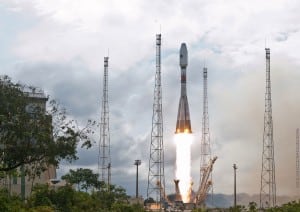Latest News
[Via Satellite 07-11-2014] O3b Networks, the company dedicated to reaching “the other three billion” with high-speed satellite connectivity, yesterday completed the launch of its second batch of four Ka-band satellites. An Arianespace Soyuz rocket carried the spacecraft into Medium Earth Orbit (MEO) at an altitude of 8,062 kilometers, or roughly 5,010 miles, releasing the satellites in two phases using a dispenser system. The completion of O3b’s second launch has made the company a global commercial service operator.
“This launch in many respects is the launch that kicks all of that off because it is the launch that allows us to fully launch commercial service,” Steve Collar, CEO of O3b told Via Satellite. “We have actually seen O3b deployed, and what we have learned from that is the performance is even better than we expected it to be … and that is even with just four satellites in the network. Now as we go to eight we double our constellation. The important thing about moving to eight satellites is now we can provide those services on a global basis.”
O3b is primarily focused on emerging markets around the equator. The new satellites expand the company’s reach across Asia, Africa, South America, Australia and the Middle East. Most important for O3b is serving the telecommunications vertical. Over the past few months O3b signed contracts with FSM Telecom, Timor Telecom and Norfolk Telecom.
In addition to serving telcos, O3b is also looking to play a big role in the maritime and energy sectors. Collar said Royal Caribbean, one of the company’s early customers, will be connecting passengers on the Oasis of the Seas cruise ship during the fourth quarter this year. The Oasis of the Seas can carry as many as 8,000 passengers. Government agencies, for both civil and defense programs, are also a target market.
Collar said the next launch for O3b is planned for early next year. While reaching eight satellites was a milestone, Thales Alenia Space has been working hard building the next four, bringing the initial constellation up to 12. Thales Alenia Space is the prime contractor for O3b’s first 12 satellites, of which the first four were launched in June 2013 on a previous Soyuz mission. But having 12 satellites in orbit means no slow-down in O3b’s pace. Collar said the company will be actively working on more satellites in the near future.
“A year from now we’ll have all 12 satellites up and operational, and we will also have more satellites under construction. We will have our second generation of satellites already under manufacturing within a year, and within two years we’ll be close to having the first of a new generation of satellites,” he said.
The size of O3b’s ultimate constellation has not been decided, but scalability was a key feature for design. Collar said the MEO constellation could be expanded to several times the initial fleet.
“Our ambition is that we will grow it very quickly. We can grow to more than 100 satellites, but we have 12 under construction or in orbit … we can launch more than 100 satellites into the same orbit, and that will increase the amount of capacity, increase the number of beams, and increase our scale. That is very much the next step for O3b,” he said.
Collar added that the satellites are being placed in a low but stable medium Earth orbit, and that the expected lifespan of each satellite could rival that of a typical geostationary satellite. Each is planned for a 10-year life, but has enough fuel to last 150 years. Collar said it would be no surprise for them to last 15 years before O3b has to think about de-orbiting. The big desire for O3b is to deliver low-cost service with a reduction in latency that makes satellite the top choice for connectivity, and bringing that connectivity to the world. However many satellites O3b chooses to build, that number will be in-line with delivering on this goal.
“We [O3b] tend to talk in terms of gigabits and hundreds of megabytes, and satellites traditionally talk about kilobytes or a few tens of megabytes. We are kind of an order of magnitude higher in terms of the bandwidth we can provide and that makes us much, much more viable in terms of providing equivalent services to fiber. It’s fiber-like performance delivered over satellite,” said Collar.
Get the latest Via Satellite news!
Subscribe Now